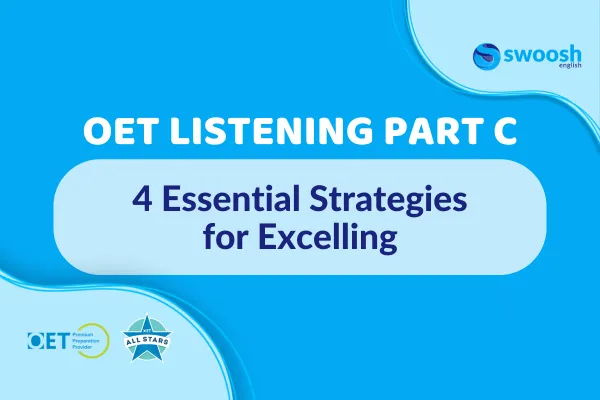Blog
Browse our library of helpful articles

4 Essential Strategies for Excelling in OET Listening Part C
Are you a healthcare professional preparing for your OET Listening test? Many candidates find Listening Part C to be the most challenging section of the OET exam. Unlike Part B, which consists of short audios with one multiple-choice question each, Part C features extended texts lasting 4-5 minutes. Staying focused during these longer recordings can be tricky due to the rapid pace of information delivery. To help you maximise your potential marks, here are four crucial tips on how to ace OET Listening Part C.
1. Adopt a Top-Down Approach
Start with a top-down approach, leveraging your background knowledge related to the topic. Just as you would approach a documentary in your native language, anticipate key points like the subject's origins, effects, preventive measures, and potential comparisons. The first line of the text always sets the stage by indicating the speaker and the topic. For example, the opening line might be, "You hear an interview with a cardiologist called Dr. Jack Robson, who is an expert on Chagas disease." This line immediately informs you that the topic will be Chagas disease, allowing you to activate your background knowledge accordingly.
2. Utilise Interview Questions as a Guide
In Part C, there are two extracts: either a presentation with one speaker or an interview with two speakers. If it is an interview, the interviewer's questions serve as prompts to focus on corresponding questions in the exam paper. For instance, if the first question from the interviewer is about why Dr. Robson regards Chagas as a neglected disease, you can expect the first question on your exam paper to align closely. This alignment provides a clear guide for navigating the recording and ensures you don't miss crucial answers.
3. Pay Attention to Signposting Language
During presentations, watch out for signposting language that signals transitions between ideas or topics. Sequencing adverbs like "first," "second," or discourse markers such as "Now" and "So" are indicative of new segments in the speech. For example, if the speaker begins with "first, let’s think about what we understand by occupational therapy," it correlates directly with the first question on the exam paper related to occupational therapy. This linguistic pattern helps listeners follow along and anticipate upcoming questions.
4. Engage with Online Interviews and Presentations
Expose yourself to a variety of English-language content, such as podcasts featuring interviews and extended monologues. Platforms like BBC podcasts offer diverse accents and examples of signposting language, similar to what you'll encounter in OET Part C. Listening to such content regularly and summarising key points afterwards is an excellent method to enhance your English proficiency and prepare for the OET Listening exam effectively.
Practice
Look at the following Listening Part C description, then answer questions 1-3:
“You hear a presentation by a specialist cancer nurse called Sandra Morton, who is talking about her work with prostate cancer patients, including a man called Harry.”
What sort of ideas come into your mind when you read the description? What sort of information or ideas would you expect to hear the nurse talk about?
Look at the question again, is it an interview or a presentation?
Look at the first two questions from the sample task:
“What does Sandra Morton see as the main aim of her work?”
“When Harry was offered a routine health check at his local surgery, he initially…”
What sort of signposting language might the speaker use to guide the listener with these questions?
Answers
Possible ideas include: the effects of prostate cancer; who is most at risk; the risk of dying; potential recovery, etc
Presentation (clearly stated in description)
Possible language includes: First, firstly, now, moving on to, so, for example, etc
So now it is over to you starting use these strategies in your OET Listening practice. Good luck with your preparation and don't forget to add your questions to the comments below.

4 Essential Strategies for Excelling in OET Listening Part C
Are you a healthcare professional preparing for your OET Listening test? Many candidates find Listening Part C to be the most challenging section of the OET exam. Unlike Part B, which consists of short audios with one multiple-choice question each, Part C features extended texts lasting 4-5 minutes. Staying focused during these longer recordings can be tricky due to the rapid pace of information delivery. To help you maximise your potential marks, here are four crucial tips on how to ace OET Listening Part C.
1. Adopt a Top-Down Approach
Start with a top-down approach, leveraging your background knowledge related to the topic. Just as you would approach a documentary in your native language, anticipate key points like the subject's origins, effects, preventive measures, and potential comparisons. The first line of the text always sets the stage by indicating the speaker and the topic. For example, the opening line might be, "You hear an interview with a cardiologist called Dr. Jack Robson, who is an expert on Chagas disease." This line immediately informs you that the topic will be Chagas disease, allowing you to activate your background knowledge accordingly.
2. Utilise Interview Questions as a Guide
In Part C, there are two extracts: either a presentation with one speaker or an interview with two speakers. If it is an interview, the interviewer's questions serve as prompts to focus on corresponding questions in the exam paper. For instance, if the first question from the interviewer is about why Dr. Robson regards Chagas as a neglected disease, you can expect the first question on your exam paper to align closely. This alignment provides a clear guide for navigating the recording and ensures you don't miss crucial answers.
3. Pay Attention to Signposting Language
During presentations, watch out for signposting language that signals transitions between ideas or topics. Sequencing adverbs like "first," "second," or discourse markers such as "Now" and "So" are indicative of new segments in the speech. For example, if the speaker begins with "first, let’s think about what we understand by occupational therapy," it correlates directly with the first question on the exam paper related to occupational therapy. This linguistic pattern helps listeners follow along and anticipate upcoming questions.
4. Engage with Online Interviews and Presentations
Expose yourself to a variety of English-language content, such as podcasts featuring interviews and extended monologues. Platforms like BBC podcasts offer diverse accents and examples of signposting language, similar to what you'll encounter in OET Part C. Listening to such content regularly and summarising key points afterwards is an excellent method to enhance your English proficiency and prepare for the OET Listening exam effectively.
Practice
Look at the following Listening Part C description, then answer questions 1-3:
“You hear a presentation by a specialist cancer nurse called Sandra Morton, who is talking about her work with prostate cancer patients, including a man called Harry.”
What sort of ideas come into your mind when you read the description? What sort of information or ideas would you expect to hear the nurse talk about?
Look at the question again, is it an interview or a presentation?
Look at the first two questions from the sample task:
“What does Sandra Morton see as the main aim of her work?”
“When Harry was offered a routine health check at his local surgery, he initially…”
What sort of signposting language might the speaker use to guide the listener with these questions?
Answers
Possible ideas include: the effects of prostate cancer; who is most at risk; the risk of dying; potential recovery, etc
Presentation (clearly stated in description)
Possible language includes: First, firstly, now, moving on to, so, for example, etc
So now it is over to you starting use these strategies in your OET Listening practice. Good luck with your preparation and don't forget to add your questions to the comments below.
© 2023 - All Rights Reserved

